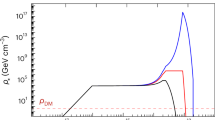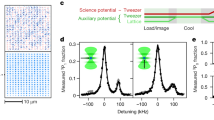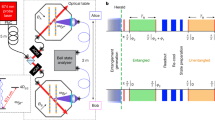Abstract
The cosmological applications of atomic clocks1,2,3 so far have been limited to searches for the uniform-in-time drift of fundamental constants4. We point out that a transient-in-time change of fundamental constants can be induced by dark-matter objects that have large spatial extent, such as stable topological defects5 built from light non-Standard Model fields. Networks of correlated atomic clocks, some of them already in existence6, such as the Global Positioning System, can be used as a powerful tool to search for topological defect dark matter, thus providing another important fundamental physics application for the ever-improving accuracy of atomic clocks. During the encounter with an extended dark-matter object, as it sweeps through the network, initially synchronized clocks will become desynchronized. Time discrepancies between spatially separated clocks are expected to exhibit a distinct signature, encoding the defect’s space structure and its interaction strength with atoms.
This is a preview of subscription content, access via your institution
Access options
Subscribe to this journal
Receive 12 print issues and online access
$259.00 per year
only $21.58 per issue
Buy this article
- Purchase on SpringerLink
- Instant access to full article PDF
Prices may be subject to local taxes which are calculated during checkout



Similar content being viewed by others
References
Chou, C. W., Hume, D. B., Koelemeij, J. C. J., Wineland, D. J. & Rosenband, T. Frequency comparison of two high-accuracy Al+ optical clocks. Phys. Rev. Lett. 104, 070802 (2010).
Bloom, B. J. et al. An optical lattice clock with accuracy and stability at the 10−18 level. Nature 506, 71–75 (2014).
Levine, J. Introduction to time and frequency metrology. Rev. Sci. Instrum. 70, 2567–2596 (1999).
Rosenband, T. et al. Frequency ratio of Al+ and Hg+ single-ion optical clocks; metrology at the 17th decimal place. Science 319, 1808–12 (2008).
Vilenkin, A. Cosmic strings and domain walls. Phys. Rep. 121, 263–315 (1985).
Predehl, K. et al. A 920-Kilometer optical fiber link for frequency metrology at the 19th decimal place. Science 336, 441–444 (2012).
Beringer, J. et al. Review of particle physics. Phys. Rev. D 86, 010001 (2012).
Bertone, G. (ed) Particle Dark Matter: Observations, Models and Searches (Cambridge Univ. Press, 2010).
Essig, R. et al. Dark sectors and new, light, weakly-coupled particles. Preprint at http://arxiv.org/abs/1311.0029 (2013).
Olive, K. A. & Pospelov, M. Environmental dependence of masses and coupling constants. Phys. Rev. D 77, 043524 (2008).
Abrikosov, A. A. On the magnetic properties of superconductors of the second group. Sov. Phys. JETP 5, 1174–1182 (1957).
Nielsen, H. B. & Olesen, P. Vortex line models for dual strings. Nucl. Phys. B 61, 45–61 (1973).
Pospelov, M. et al. Detecting domain walls of axionlike models using terrestrial experiments. Phys. Rev. Lett. 110, 021803 (2013).
Pustelny, S. et al. The Global Network of Optical Magnetometers for Exotic physics (GNOME): A novel scheme to search for physics beyond the Standard Model. Ann. Phys. 525, 659–670 (2013).
Flambaum, V. V. & Dzuba, V. A. Search for variation of the fundamental constants in atomic, molecular, and nuclear spectra. Can. J. Phys. 87, 25–33 (2009).
Allan, D. Statistics of atomic frequency standards. Proc. IEEE 54, 221–230 (1966).
Barnes, J. A. et al. Characterization of frequency stability. IEEE Trans. Inst. Meas. IM-20, 105–120 (1971).
Atomic Clock Ensemble in Space (ACES), http://www.esa.int/SPECIALS/HSF_Research/SEMJSK0YDUF_0.html
Acknowledgements
We would like to thank N. Fortson, P. Graham, J. Hall, M. Murphy, J. Sherman, J. Weinstein and I. Yavin for discussions. This work was supported by the US National Science Foundation, the Natural Sciences and Engineering Research Council of Canada, and the province of Ontario.
Author information
Authors and Affiliations
Contributions
Both authors contributed to the work equally.
Corresponding author
Ethics declarations
Competing interests
The authors declare no competing financial interests.
Supplementary information
Supplementary Information
Supplementary Information (PDF 751 kb)
Rights and permissions
About this article
Cite this article
Derevianko, A., Pospelov, M. Hunting for topological dark matter with atomic clocks. Nature Phys 10, 933–936 (2014). https://doi.org/10.1038/nphys3137
Received:
Accepted:
Published:
Issue date:
DOI: https://doi.org/10.1038/nphys3137
This article is cited by
-
Experimental realization of a 12,000-finesse laser cavity based on a low-noise microstructured mirror
Communications Physics (2023)
-
Unveiling time-varying signals of ultralight bosonic dark matter at collider and beam dump experiments
Communications Physics (2023)
-
Quantum networks with neutral atom processing nodes
npj Quantum Information (2023)
-
Quantum-limited optical time transfer for future geosynchronous links
Nature (2023)
-
The development of active optical clock
AAPPS Bulletin (2023)



